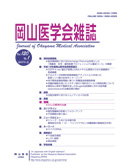

Journal of Okayama Medical Association
Published by Okayama Medical Association<Availability>
Full-text articles are available 3 years after publication.
Permalink : https://ousar.lib.okayama-u.ac.jp/13903
Studies on the pathogenesis of PIE syndrome Part 1. Evaluation of cellular responses in bronchoalveolar lavage fluid of patients with PIE syndrome
Sato, Kyo
Published Date
1993-02-27
Abstract
The bronchoalveolar lavage (BAL) fluid of patients with PIE syndrome characterized by pulmonary eosinophilia was examined to determined the cellular response in the lungs. Evaluation of cellular components in the BAL fluid revealed an increased proportion not only of eosinophils but also of lymphocytes and neutrophils. In about half of the patients with PIE syndrome the level of eosinophilia was higher in the peripheral blood than in the BAL fluid. Patients with PIE syndrome were classified into prolonged PIE and PIE with asthma based on Crofton's classification. The percentage of neutorphils and eosinophils in BAL fluid were higher in patients with prolonged PIE than in PIE with asthma while the percentage of lymphocytes was higher in a group of PIE with asthma. On the other hand, the lymphocyte precentage in BAL fluid was higher in patients with PIE syndrome due to fungus antigen than in those with PIE syndrome due to drug allergy. These findings suggest that various cellular components play important roles in the pathogenesis of PIE syndrome and that the accumulation of the effector cells in the lungs is regulated by an allergic mechamism.
Keywords
bronchoalveolar lavage
PIE syndrome
eosinophil
lymphocyte
neutrophil
ISSN
0030-1558
NCID
AN00032489
